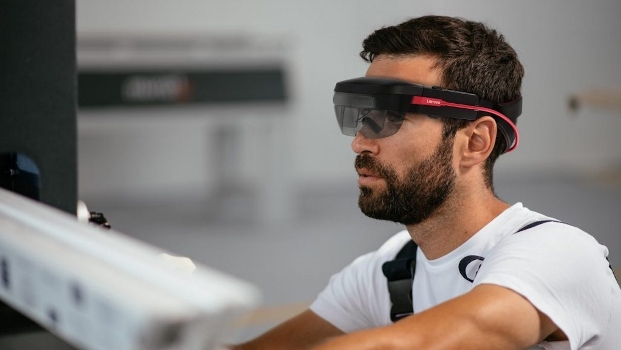
Lenovo leans towards business with ThinkReality A6 AR/VR headset
Lenovo is the latest manufacturer to develop an augmented reality (AR) device aimed at enhancing productivity for enterprise workers, along with a software platform for app creation.
The ThinkReality A6 is a ‘heads-up, hands free’ mobile visor that overlays 3D graphics onto real-world environments. The headset, reminiscent of Microsoft’s HoloLens 2 device, has a 40-degree diagonal field of view, with 1080p resolution per eye. Launch date and pricing for the set-up, unveiled on Monday, has not yet been announced.
This is not the Chinese firm’s first foray into the virtual reality (VR) market. A mixed-reality Windows headset was launched last year, for example, as well as the standalone Mirage Solo. However the ThinkReality A6 headset is designed specifically for the enterprise, such as for industrial workers.
Potential benefits include the ability for field technicians to receive remote assistance, reducing repair times and eliminating errors as well as improving training quality and offering new ways to collaborate.
The device weighs 380g, making it one of the lightest headsets on the market, Lenovo said. The light weight was achieved in part by Lenovo’s decision to house computing components on a separate, tethered device that can be worn on a belt, reducing the headset’s weight. (Fatigue can be an issue for workers who use a headset for hours at a time.)
“We have engineered this product in partnership with a number of industrial and healthcare customers, who explained that the number one issue of the products on the market is the weight distribution, to really use a product like this in a day-long environment,” said Christian Teismann, senior vice president for Lenovo’s commercial business, during a keynote presentation at Lenovo Accelerate in Orlando, Fla. this week.
Enterprise opportunity attracts tech vendors
AR and VR have so far failed to gain signification traction with consumers, but interest is higher in the enterprise. Commercial deployments will account for a large proportion of the $20.4 billion forecast to be spent on these kinds of devices this year, according to IDC; that’s up from $12.1 billion in 2018.
Use cases have emerged around workplace training (such as Walmart, which rolled out 17,000 Oculus Go devices to staff at its stores); collaboration; remote assistance; and data visualisation. In what may lead to the largest deployment of the technology to date, the US Army has begun a pilot development project. If successful, it could result in the rollout of 100,000 adapted HoloLens 2 devices to soldiers for use in combat situations.
A wide range of vendors has flocked to the market with business-focused devices. In addition to Microsoft, which recently released the second iteration of its mixed-reality HoloLens, Google continues to sell Glass devices for business use, while Magic Leap and Facebook also sell AR and VR headsets aimed at the enterprise. Established hardware manufacturers like HP, HTC, Dell and Toshiba also have AR products.
ThinkReality software platform
In addition to the A6 headset and consulting services, Lenovo will also launch the ThinkReality Platform to support creation of AR and VR applications. The platform will be device- and cloud-agnostic, Lenovo said, with apps supported across multiple operating systems.
“Apps are critical for uptake of AR/MR in the business space, therefore, having a platform to support apps development is very important. I assume that is why Lenovo has launched ThinkReality platform,” said Annette Jump, a research director at Gartner.
“The big question will be how many developers Lenovo will be able to attract to use it. For sure it will be challenging for them to compete with Microsoft, Google and Apple in this space.”
IDG News Service







Subscribers 0
Fans 0
Followers 0
Followers